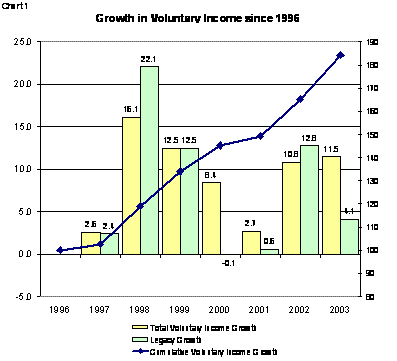Institute of Fundraising welcomes Fundratios report which shows Fundratios Charities obtaining higher growth

The latest Fundratios report, the charity fundraising benchmarking project, operated by the Centre for Interfirm Comparison and the Institute of Fundraising showed continued growth in voluntary income and an improvement in returns on investment in fundraising. One of the main factors has been the benefit now flowing from earlier years heavy investment in committed giving. Lindsay Boswell, CEO of the Institute, said, "This makes it clear and simple that growth in fundraising is linked to creation of a diverse fundraising strategy underpinned by sound investment in a variety of fundraising techniques."

The 2003 project was completed in November. Forty-two charities with a combined voluntary income of almost £1.5 billion took part. Most of the data related to financial years ending in the period between March and June 2003. It is therefore more recent and of course far more detailed than analysis based on any published accounts.
Advertisement
Charities in the project have reported growth in each of the last 10 years but the rate of growth slowed markedly between 1998 and 2001 in which year it was just 2.7%. It accelerated again in 2002 (up 10.8%) and in 2003 that growth continued with an increase of 11.5%. As in most recent years the growth has come to a large extent from active fundraising (i.e. excluding legacies) see Chart 1.
Being by far the largest source of voluntary income (38%), legacies have a substantial and, particularly at individual charity level, rather random influence on growth.
This year legacy income grew by a satisfactory 4.1% while non-legacy income grew by 15.7% giving overall growth of 11.7%.
Central to this growth was the increased income from committed giving which is now the largest source of voluntary income after legacies. It provided 17% of all voluntary income, 28% of non-legacy income. It grew by 18.3% during the year, 69% over a 3-year period. Other activities which grew well during the year were trusts, corporate, special events and the small but rapidly growing income from major donor fundraising programmes. Chart 2 shows the sources of voluntary income of participants in the study.

With an overall growth rate of 11.7% and only 3.4% rise in expenditure, the average return from fundraising has increased from £5.09 to £5.51. If legacies are excluded, the average rose from £3.50 to £3.85.
This year has seen a maturing of the committed giving campaigns which have been such a feature of fundraising in the past few years. Last year investment in obtaining new committed givers rose by 70%. This year expenditure fell by 3.6% although it remains the main area of expenditure, accounting for 25% of fundraising budgets. Having invested heavily in building up their committed giver base, some of the larger charities are now spending only to maintain and replenish that base. In consequence the typical return has risen from £3.43 to £4.07; as others reach this situation the returns should continue to improve. Some smaller charities continued to invest heavily. For example, those charities with a voluntary income of over £22 million (the middle value for the group) spent 7% less whilst smaller charities spent 30% more.
The average returns from fundraising are shown below:

Note for Editors:
1. ‘Fundratios’, operated by the Centre for Interfirm Comparison in cooperation with the Institute of Fundraising is a management tool for fundraising professionals.
It enables them to benchmark their fundraising activities against those of other leading charities. Over 80 charities, large and small, have taken part in the study, many on a regular basis. It is a unique source of in-depth information on the growth, costs and returns of every fundraising activity, from shops to special events, committed giving to corporate ventures.
2. The Institute of Fundraising (registered charity number 1079573) is a membership organisation committed to the highest standards in fundraising management and practice. Members are supported through training, networking, the dissemination of best practice and representation on issues that affect the fundraising environment. The Institute of Fundraising is the largest individual representative body in the voluntary sector with 3,500 individual members and 140 affiliated organisations. Membership reflects income to the sector of some 5 billion per annum and delivers more than £12 billion service-output covering all areas of social activity.
3. Contact Lindsay Boswell, Chief Executive or Andrew Watt, Head of Policy and Standards and Deputy Chief Executive on 020 7627 3436 for further information.



